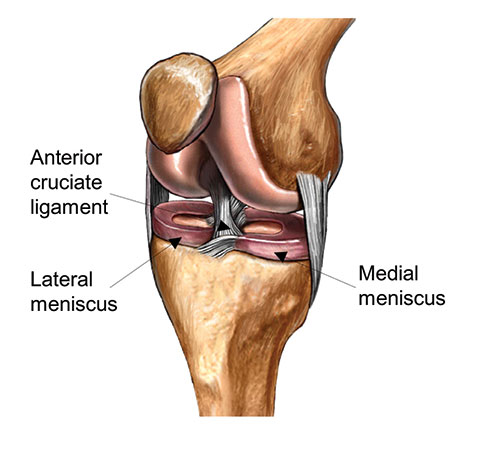If you tear the anterior cruciate ligament (ACL) in your knee, you may need to have reconstructive surgery. The ACL is a tough band of tissue joining the thigh bone to the shin bone at the knee joint. It runs diagonally through the inside of the knee and gives the knee joint stability. It also helps to control the back-and-forth movement of the lower leg. The ACL or anterior cruciate ligament plays a key role in your knee joint by providing stability.
When you tear or rupture this ligament, your knee can collapse or buckle when you twist or turn it.
Knee injuries can occur during sports such as skiing, tennis, squash, football and rugby. ACL injuries are one of the most common types of knee injuries, accounting for around 40% of all sports injuries.
You can tear your ACL if your lower leg extends forwards too much. It can also be torn if your knee and lower leg are twisted. It is also not unusual for other knee parts to sustain injury at the same time. These include tearing cartilages or damaging the joint surface. Common causes of an ACL injury include:
- landing incorrectly from a jump
- stopping suddenly
- changing direction suddenly
- having a collision, such as during a football tackle
If the ACL is torn, your knee may become very unstable and lose its full range of movement. This can make it difficult to perform certain movements, such as turning on the spot. Some sports may be impossible to play.
How you can benefit from this surgery?
A torn ACL can’t be repaired by stitching it back together. But it can be reconstructed by grafting (attaching) new tissue on to it.
The ACL can be reconstructed by removing what remains of the torn ligament and replacing it with a tendon from another area of the leg, such as the hamstring or patellar tendon.
The patellar tendon attaches the bottom of the kneecap (patella) to the top of the shinbone (tibia).A successful result from an ACL reconstruction often means that the knee is no longer prone to collapsing. This enables you to continue to enjoy sporting activities and benefit from an active lifestyle.
What does an ACL reconstruction involve?

Various anaesthetic techniques are possible for the operation which generally takes between an hour and an hour and a half.
During the ACL reconstruction your surgeon will make one or more cuts around your knee area. They may choose to look inside your knee joint using a camera, also known as an arthroscopy or keyhole surgery.
Using a suitable portion of tissue from another part of your body, your surgeon will replace the damaged anterior cruciate ligament. This will be done by securing the ends of the replacement ACL to the bone using anchors or special screws.
What complications could you experience?
ACL surgery fully restores the functioning of the knee in more than 80% of cases. ACL surgery will improve the stability of your knee and stop it giving way. You should be able to resume normal activities after six months.
But your knee may not be exactly like it was before the injury, and you may still have some pain and swelling. This may be because of other injuries to the knee, such as tears or injuries to the cartilage, which happened at the same time as or after the ACL injury.
As with all types of surgery, there are some small risks associated with knee surgery, including infection, a blood clot, knee pain, and knee weakness and stiffness. General complications include:
- infection – the risk of infection is small (less than 1%); you may be given an antibiotic after your operation to prevent infection developing
- blood clot – the risk of a blood clot forming and causing problems is very low (about 1 in 1,000); if you’re thought to be at risk, you may be given medication to prevent blood clots forming
- knee pain – affects almost 2 in 10 of people who have ACL surgery and is more likely to occur when the patellar tendon is used as graft tissue; you may have pain behind your kneecap or when kneeling down or crouching
- knee weakness and stiffness – some people experience long-term weakness or stiffness in their kneeBreak of the kneecap
How long will you take to recover?
Most people are able to go home on the same day or the day after the ACL reconstruction operation.
It is common for your surgeon to suggest that you wear a knee brace for a few weeks after the procedure.
Intensive physiotherapy is also recommended once your knee has calmed down after surgery. The treatment may last for up to six months.
Returning to normal activities quickly can be achieved through regular exercise.
After having reconstructive ACL surgery, a few people may still experience knee pain or instability.
Recovering from surgery usually takes around 6 months, but it could be up to a year before you’re able to return to full training for your sport. It is possible that your knee will never be quite as strong as it was before you injured it.
